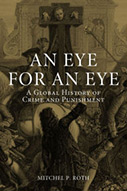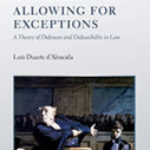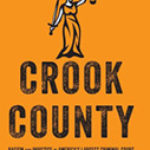An Eye for an Eye: A Global History of Crime and Punishment

Author: Michael P. Roth.
Publisher:London: Reaktion Books, 2015. 342p.
Reviewer: Wilbur Miller | November 2015
This book is certainly global, spanning time from prehistory to the present and space from Afghanistan to Van Demien’s Land (Zanzibar is not mentioned). Chapter five is the heart of the book, because it identifies different legal traditions that serve as an implicit organizing principle for the vast amount of information Roth presents. Law codes are a major development in civilization, replacing individual vengeance with the authority of the state. It is important that the state extract the eye of the offender rather than the victim or his or her family. Although Middle Eastern codes like Hammurabi’s allowed for compensation of victims, the state set the terms of the compensation. Contemporary traditions are the Roman or civil law tradition of continental Europe and its former colonies; the English common law tradition adopted by old and newer colonies as well; and the Islamic and the Chinese or Confucian traditions. Roth adds a fifth tradition, maintained only by the Chinese among large nations, the socialist tradition. Since crime is defined by law, how civilizations define crimes and punishments and establish enforcement mechanisms is the foundation of each of these traditions.
Within the various legal traditions and the societies that embodied them, Roth develops several themes. A major focus is the role that religious values, indirectly or directly, have played in legal systems. Sometimes religions and secular law are one, as in Sharia law and the codes of the colonial American Puritans. Other times, as in the western legal traditions, religious values are the distant roots of basic definitions of crime, even though punishments have evolved far from the original religious prescriptions. One trend of the west is the steady divorce from the religious connection, with former crimes like blasphemy, sodomy, fornication, and adultery disappearing from the law books.
Another important theme in secular societies is the replacement of public punishments intended to shame criminals and deter spectators by imprisonment. Public punishments, of course, survive in Middle Eastern societies that have revived or revised Sharia law to emphasize its strictest prohibitions and punishments. In the United States at least, shaming has returned in publications of lists of convicted sex offenders on the internet, and the names of people convicted of drunken driving. In the secular societies of the west, imprisonment was originally for people pending trial, or in despotic regimes a place to permanently confine alleged offenders against the monarch or state. In the later eighteenth century, rehabilitation — using punishment to make the prisoner into a constructive citizen on release, became the goal of reformers who created the penitentiary in England and America. Inmates were given plenty of time to do penance, sometimes entirely in solitary confinement. Efforts to rehabilitate convicts subsequently went through many phases, culminating in the system of parole, or release from prison for good conduct within the prison.
Roth devotes a chapter to criminal gangs in different times and places – brigands in early modern Europe, English highwaymen in the 18th century, thugs and dacoits in old and new India, Australian bushrangers, and gangs in the American West in the 19th century. Another chapter interestingly includes pirates and slave traders over the world as forms of globalized organized crime, along with the more familiar mafias of various sorts and nationalities.
“The Face of Modern Murder” begins with one of the world’s most ancient apparent murders– the “Iceman” — whose body was discovered by hikers in the Alps. The remarkably preserved body revealed that he was killed by an arrow in his back and that he had fought with his assailants. From this ancient crime, Roth moves through vampire and werewolf legends, sexual and serial murders, South African Muti murders (killing people for body parts used in traditional medicine), and finally reminds us that the Malay “running amok” is a different culture’s version of western spree and mass killings. Roth’s coverage of murder, the least common crime, gives a good idea of his wide ranging treatment.
One important theme surprisingly missing is policing, which is not even in the index. Since the police are the ordinary person’s face of the law, they seem to deserve more attention than Roth has given, especially because he includes them in his previous excellent textbook on the history of the U.S. criminal justice system.
Although specialists in various aspects of crime and punishment will find no surprises, even they will profit from Roth’s global vision; while other readers will find each specific discussion a valuable introduction to each of the complex areas of crime and punishment he discusses. Despite the missing police officers, this book is encyclopedic in coverage.
Wilbur Miller, Professor, Department of History, Stony Brook University


